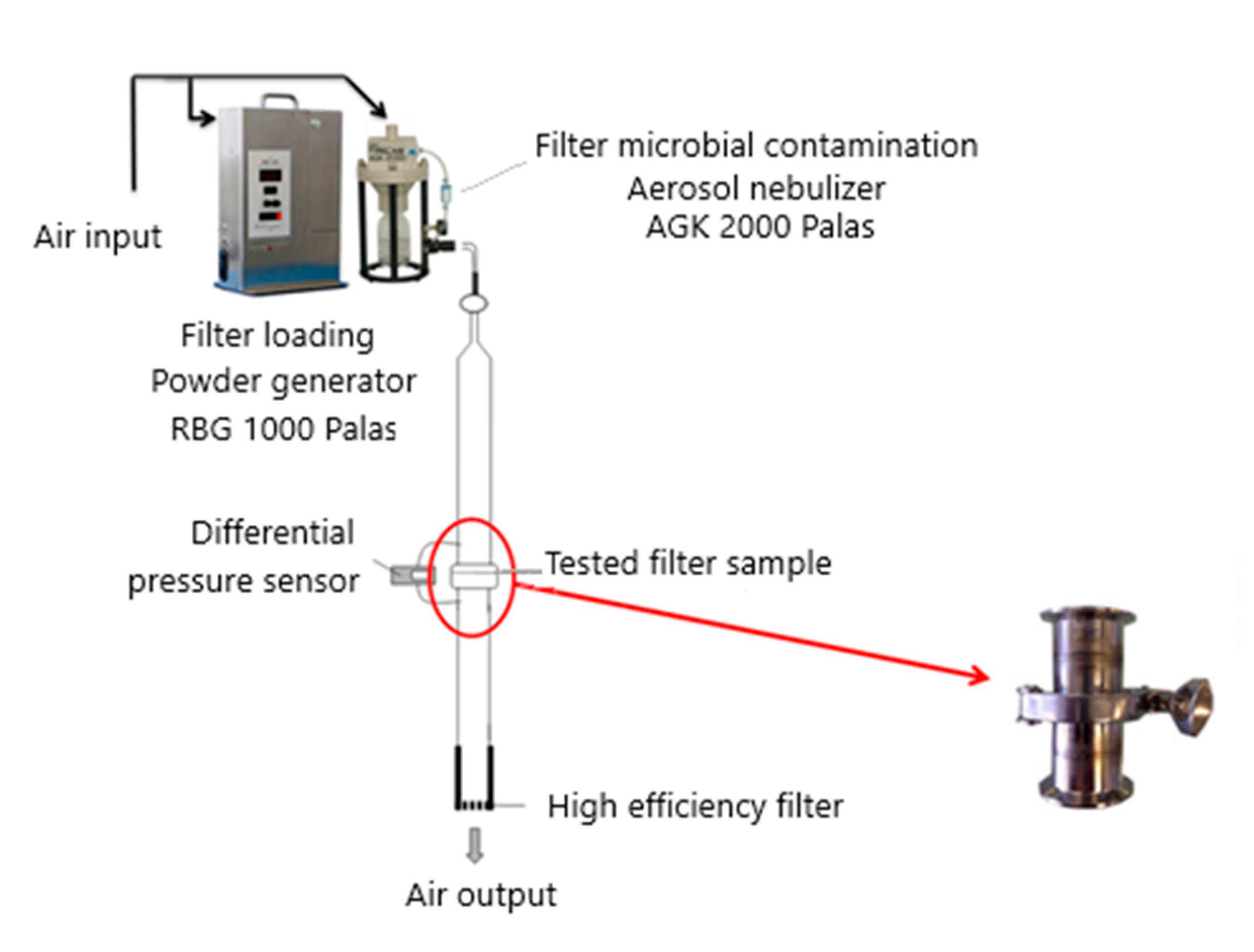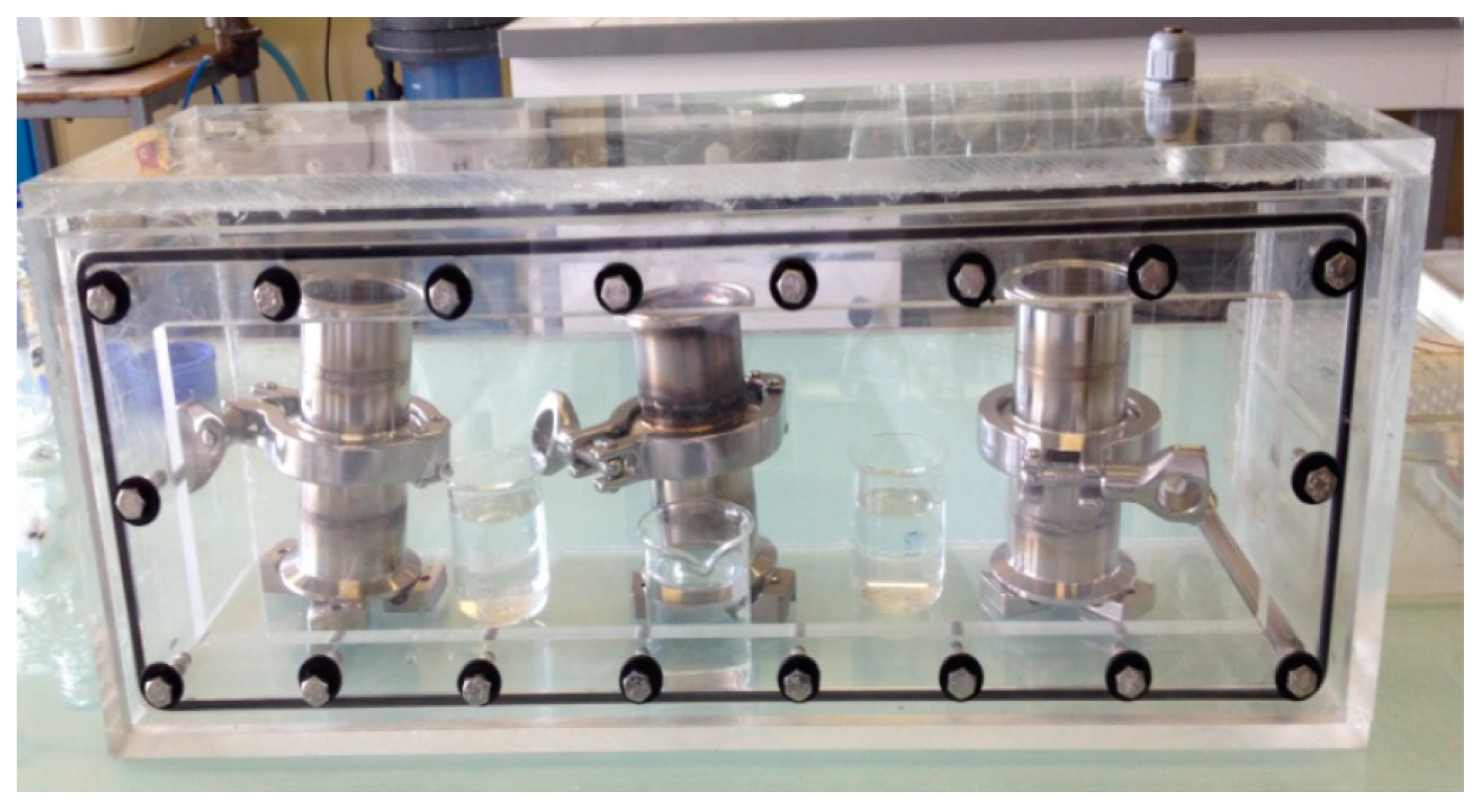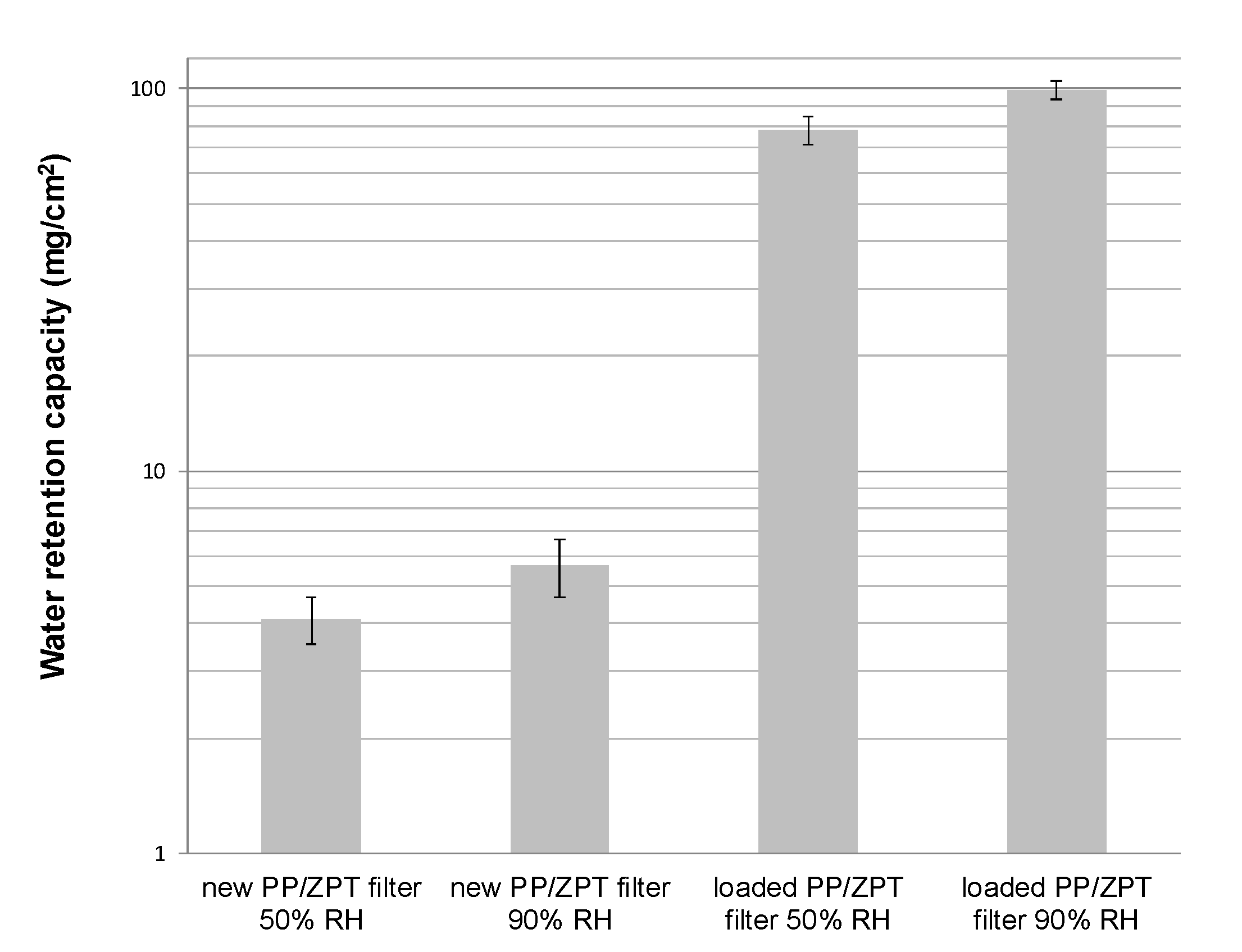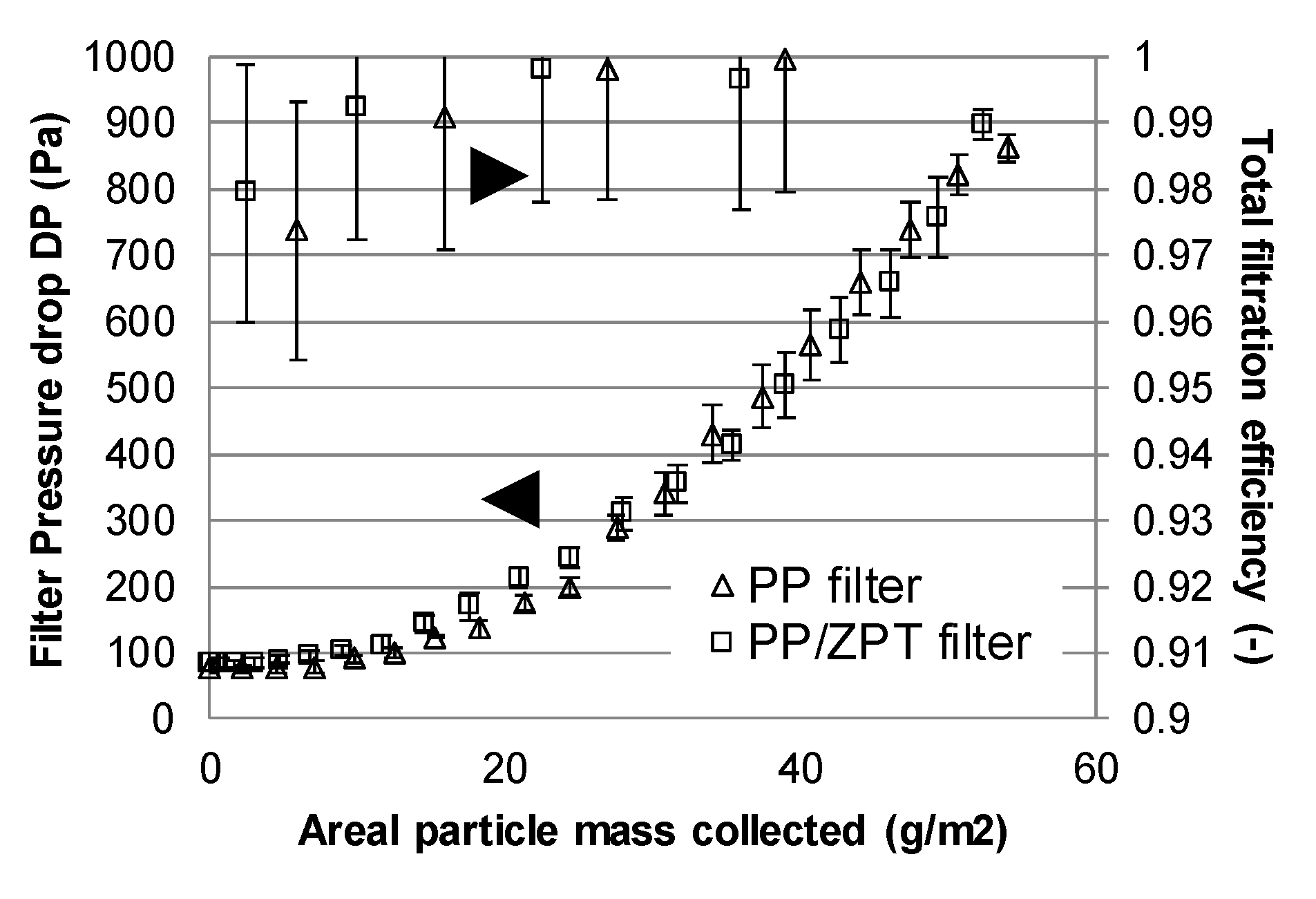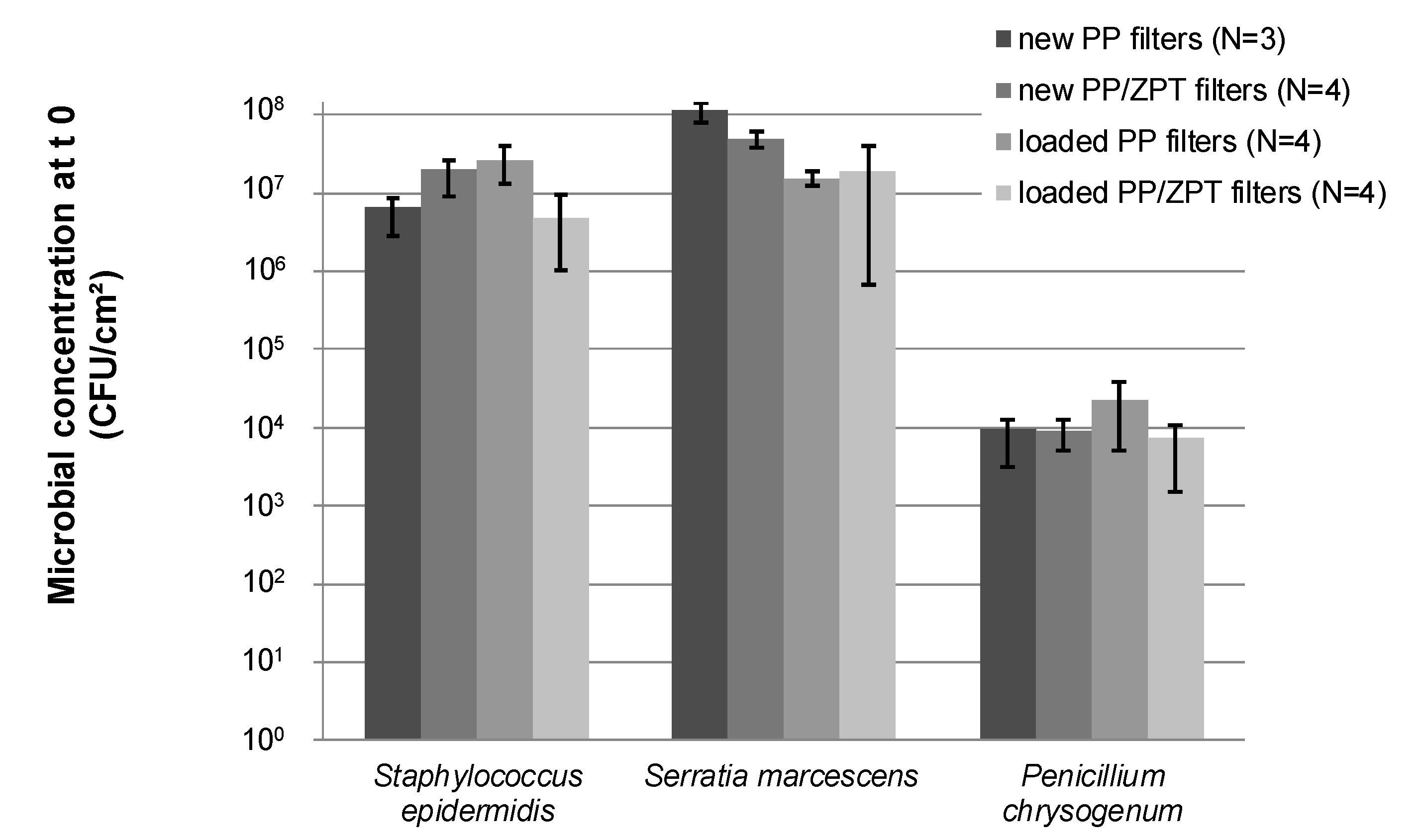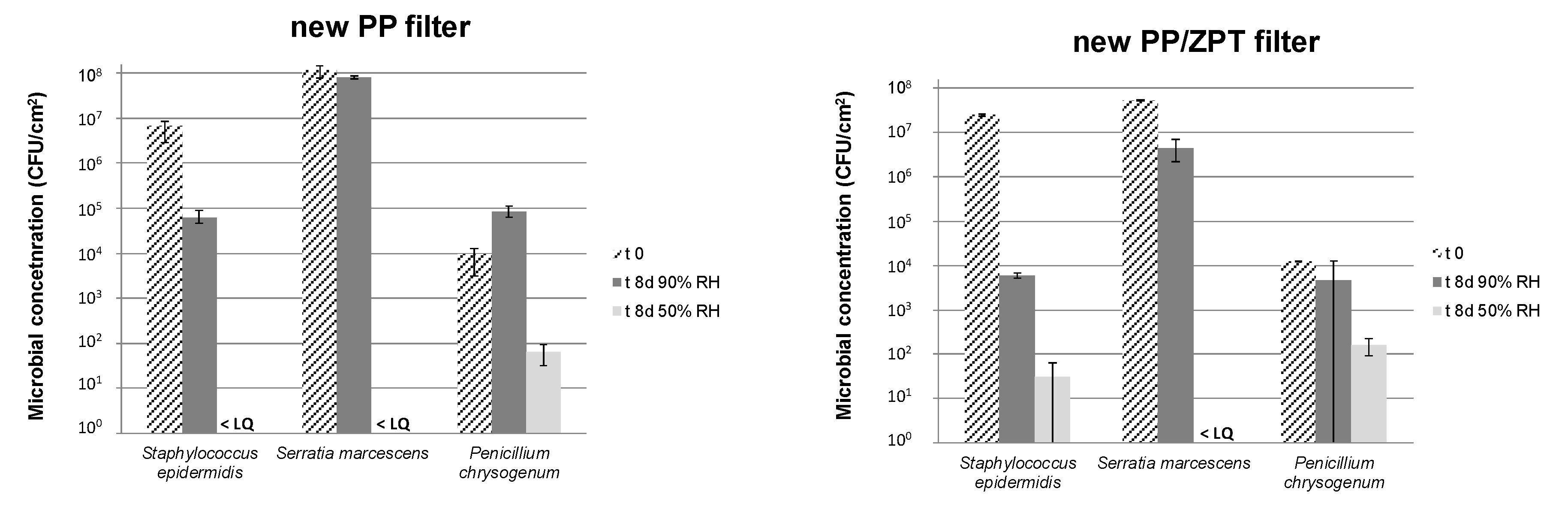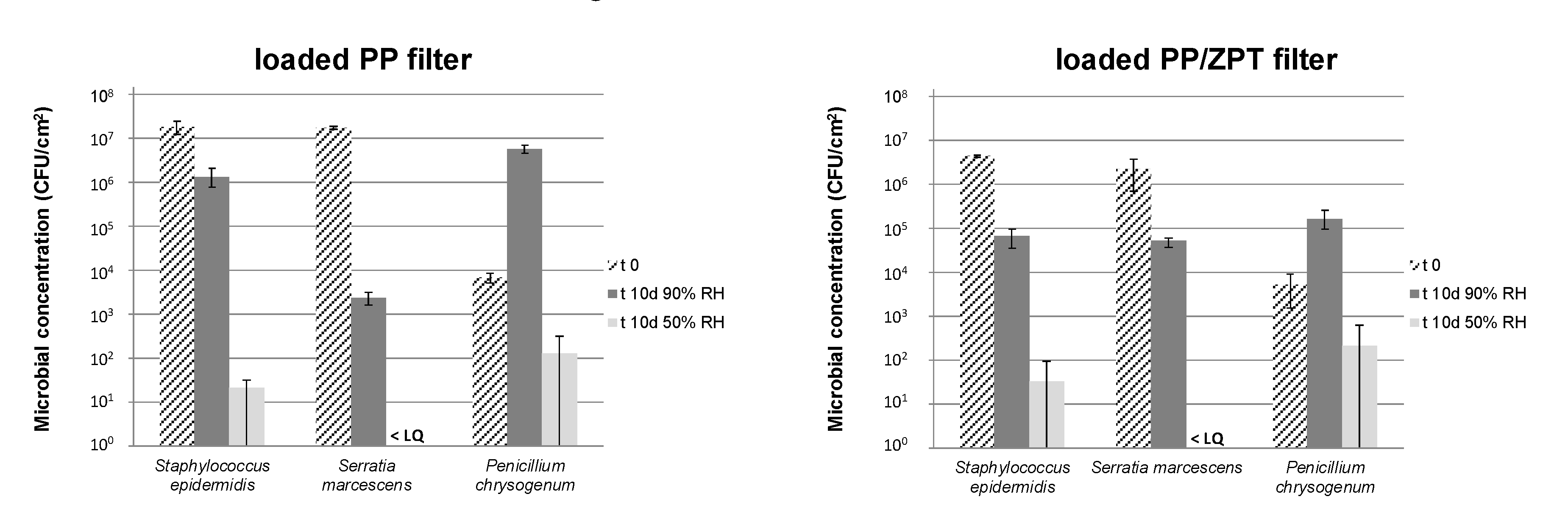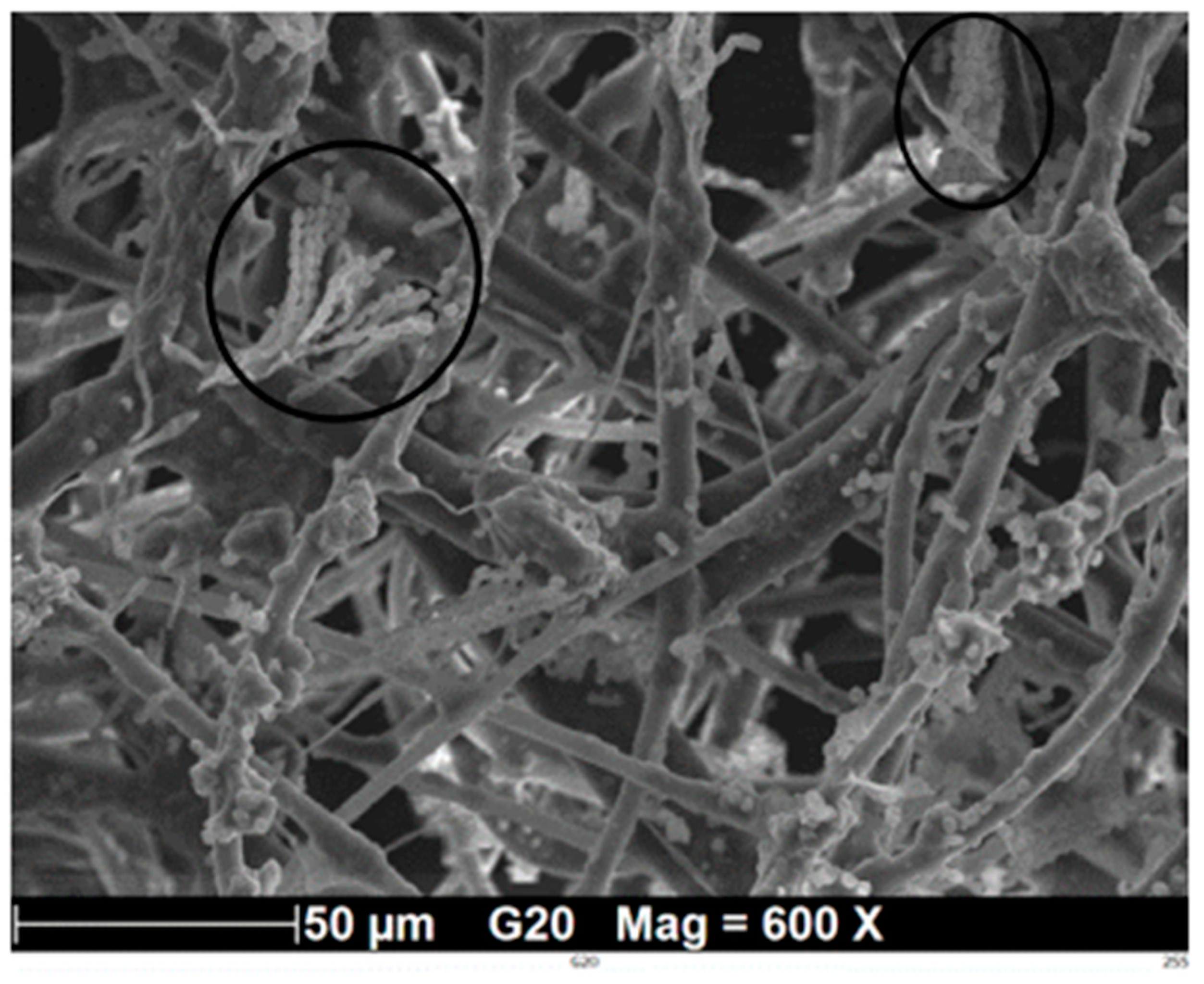1. Introduction
Indoor air pollution refers to a variety of chemical, biological and physical agents that pose a health threat or cause discomfort. Airborne particles or aerosols are responsible for about 5–34% of all indoor pollution, and their abundance depends on indoor moisture and temperature conditions [
1,
2]. Bioaerosols are essentially composed of allergens, bacteria, molds, fungi, spores, endotoxins, mycotoxins and all types of particles produced by living organisms with highly variable and complex characteristics. Bioaerosols and, more specifically, microbial aerosols are of major concern in office and commercial buildings because of the close relationship with health diseases (episodes of asthma, rhinitis, conjunctivitis, etc.) [
3].
The number of people exposed to bioaerosols in indoor environments can be reduced by appropriate air renewal or air cleaning processes such as filtration, ultraviolet germicidal irradiation, photocatalytic oxidation [
4] or plasmacluster ions [
5]. For example, the effectiveness of negative ions was investigated on the survival of
Serratia marcescens and
Staphylococcus epidermidis in an air duct flow [
6]. Despite the existence of advanced treatment technologies for bioaerosol inactivation, the most common technique implemented in air handling units of heating ventilation and air-conditioning (HVAC) systems remains filtration with fibrous filters, allowing the collection of bioaerosols, although leading to a possible microbial contamination of the filters with microbial growth.
Microbial growth onto HVAC filters was observed in the literature under laboratory conditions [
7,
8,
9,
10], and also in real conditions [
11,
12], with possible degradation of the microbial indoor air quality. To address this issue, innovative air filters with photocatalytic properties [
13] or containing antimicrobial treatments are designed to be implemented in HVAC systems, or in portable room air cleaners or automobiles. The antimicrobial agents are various, e.g., nanoparticles of copper or silver, or carbon nanotubes [
14]. Many natural antimicrobial products have been discovered; e.g.,
Sophora flavescens nanoparticles revealed an inactivation efficiency against
S. epidermidis between 35 and 72% according to the level of humidity [
15]. The activity of
Melaleuca alternifolia oil (tea tree oil) against a range of microorganisms including
Staphyloccocus aureus,
Escherichia coli,
Candida albicans and
Aspergillus niger was shown [
16]. The antimicrobial activities of 44 pure natural compounds and two derivatives were determined with only 23 compounds effective in inhibiting the growth of the tested organisms (
S. aureus,
Bacillus subtilis,
Escherichia coli,
Pseudomonas aeruginosa and
Candida albicans) [
17].
The antimicrobial efficiency of the coating or treatment varies according to the antimicrobial agent and, in particular, may depend on whether the filters are new or loaded. The main issue with antimicrobial air filters is that the coating may lead to changes in the filtration performance [
18,
19], particularly by increasing the airflow resistivity of the filter.
Zinc pyrithione (ZPT) with the chemical formula C
10H
8N
2O
2S
2Zn, also known as Zinc Omadine or Zinc 2-pyridinethiol-1-oxide, is used to prevent microbial degradation and deterioration of manufacturing starting materials such as plastics, polymers and latexes, and in a wide range of finished articles made from these starting materials. This chemical acts to prevent the growth of bacteria, fungi, mildew and algae that can cause various types of deterioration such as discoloration, staining and odors. ZPT was found to have a safety profile and/or antimicrobial efficacy that exceeded iodine, chlorhexidine gluconate and triclosan [
20]. It acts as an ionophore, interacting nonspecifically with the plasma membrane and shuttling copper into the cell. There is a precedent for pyrithione-mediated ionophore activity across intracellular membranes, as it was previously reported that pyrithione affected zinc transport across vacuole vesicles in vitro [
21]. The results of most studies on fungi showed that ZPT inhibits fungal growth through damaging iron–sulfur clusters of proteins essential for fungal metabolism and also by depolarizing the cell membranes and preventing membrane transport.
The aim of this study was to investigate, under laboratory conditions, the antimicrobial efficiency of a marketed filter containing zinc pyrithione which is known for its effect against microorganisms. The filtration performance of the filter, i.e., the particle collection efficiency and the pressure drop, and the antimicrobial effectiveness regarding a bacteria–fungi consortium, i.e., the ability to inhibit the growth of microorganisms during the incubation period, were evaluated and compared to the performance of a regular filter with the same classification. The effect of the level of humidity during filter conditioning as well as the presence of filter loading with organic particles was investigated.
2. Materials and Methods
2.1. Fibrous Filters Tested
Two multi-layer polypropylene (PP) fibrous filters marketed by Lydall, both of them containing electrostatic charges and classified as F7 according to the European standard EN 779:2002, were studied: a PP filter containing antimicrobial treatment with zinc pyrithione (ZPT) named the PP/ZPT filter, and a regular PP filter without antimicrobial treatment. Few antimicrobial HVAC filters are currently commercially available, perhaps because of the potential toxicity or negative effect of some antimicrobial agents, such as triclosan, which is suspected of increasing antibiotic resistance. The antimicrobial filter with ZPT selected for this study is one of the few commercially available filters.
F7 class filters, in particular, the 2 tested filters, are widely used in the air handling unit of HVAC systems of commercial or office buildings in the first or second treatment stage. The multi-layer PP filters provide high filtration efficiency and dust holding while minimizing airflow resistance, but the fibers lose their charge due to particle loading and air humidity, reducing the efficiency of the filters.
The two filters were each composed of five layers: a spunbond layer (SP1), a meltblown layer (MB1) containing the zinc pyrithione in the case of the PP/ZPT filter, a meltblown layer (MB2), a meltblown layer (MB3) containing pink pigments (reference color for F7 class efficiency), a spunbond layer (SP2). The two SP layers ensure the mechanical resistance of the filters, and there is an increasing gradient of efficiency between the MB1 and MB3 layers. The MB1 layer of the PP/ZPT filter is obtained by fusion of regular PP granules and granules containing ZPT, extrusion and then spinning.
The structural properties of the two filters were quantified (PP/ZPT filter vs. PP filter): the thickness (
) was 1.41 ± 0.08 mm vs. 1.46 ± 0.12 mm (averages and standard deviations for N = 15 quantified by micrometers); the porosity was 91.1 ± 0.3% vs. 89.0 ± 0.8% (averages and ranges for N = 2 quantified by mercury intrusion with mercury porosimeter Autopore IV 9500); the fiber median diameter of the most effective filtering layer (i.e., MB3) was 5.1; 2.9 µm vs. 4.5; 2.6 µm (median diameters; standard deviations for N = 100 fibers analyzed by picture analysis with ImageJ software from scanning electron microscopic observations with EOL JSM-5800LV); the basic weight was 136 g/m
2 vs. 139 g/m
2 (obtained from the manufacturer). The airflow resistance (
) of the new PP/ZPT and PP filters was quantified from filter pressure drop (
, Pa) measurements vs. filtration velocity (
) in a ventilated duct with airflow control:
where
is the air dynamic viscosity considering the conditions of temperature and humidity during the tests. The two types of filters were tested in a flat geometry in this study. The airflow resistance was 3.9 ± 0.1 × 10
7 m
−1 vs. 3.5 ± 0.1 × 10
7 m
−1 (averages and ranges for N = 2) for the PP/ZPT filter vs. PP filter. The results indicate a higher airflow resistance of the PP/ZPT filter compared to the PP filter. In particular, the PP/ZPT filter displayed a higher pressure drop than the PP filter by around 10% at the nominal filtration velocity of 0.12 m/s (recommended by the manufacturer), i.e., 84 Pa vs. 77 Pa. The airflow permeability of the filters (
, m
2) was calculated from
considering Darcy’s law for laminar airflow:
The airflow permeability of the filters was 3.6 ± 0.2 × 10−11 m2 and 4.1 ± 0.4 × 10−11 m2 for the PP/ZPT filter and the PP filter, respectively. Note that the range in the airflow permeability data is higher, due to the high experimental error in the thickness measurement.
The 2 tested filters display equivalent porous structural properties, but they are not similar.
The quantity of zinc in the filters was quantified at the laboratory by an atomic absorption spectrometer (AAnalyst 200, PerkinElmer) after calcination of filter samples at 550 °C for 4 h and acid attack with HCl (3N). The quantity of zinc measured was 0.15 ± 0.02 ppm for the PP/ZPT filter and 0.19 ± 0.02 ppm for the MB1 layer of the PP/ZPT filter, while there was no quantifiable value for the PP filters (i.e., below the quantification limit of 0.09 ppm). Thus, considering the basic weight of the PP/ZPT filter, the mass of zinc per surface of filtration was around 20 µg/m2.
2.2. Water Retention Capacity
The microbial growth onto fibrous filters is influenced by the air humidity [
8], but even more by the water retention capacity of the filters [
8,
10]. Water is sorbed by the fibers of the filter and/or by the particles collected by the filter according to the hydrophilic characteristics of the fibers and the particles.
The water retention capacity of the tested filters was quantified by a Karl Fisher device (870 KF Titrino plus, 803 Ti Stand, 860 KF Thermoprop, Metrohm) following the methodology described by [
10], after conditioning in an airtight container (see
Section 2.3.4) for two levels of humidity exposure: 25 °C and 90% RH (i.e., 21 g of water per m
3 of air), and 25 °C and 50% RH (i.e., 11 g of water per m
3 of air). The water retention capacity was expressed in mg of water per surface of filtration. The average values were compared by using the statistical
t-test.
2.3. Study of the Microbial Behavior on the Tested Filters
The antimicrobial effect of ZPT was tested with new filters, i.e., filters with just microbial contamination representative of the antimicrobial effect in the first operating days, and with loaded filters, i.e., loaded filters with organic and microbial particles. The tests were performed with the PP/ZPT filter and the PP filter with 3 filter samples to ensure the reproducibility of the results.
2.3.1. Preparation of the Microbial Consortium
The microbial contamination of the filters was ensured with a bacteria–fungi consortium, consisting of Staphylococcus epidermidis cells (CIP 53 124), Serratia marcescens cells (DSM30121) and Penicillium chrysogenum spores (wild strain).
S. epidermidis is a bacterial species found on the skin, and thus it is frequently present in indoor air from office buildings in particular.
S. marcescens is a motile, short rod-shaped, Gram-negative, facultative anaerobe bacterium, classified as an opportunistic pathogen, and thus its presence in air could cause some pneumonia and urinary tract infections. It is capable of producing a pigment called prodigiosin, which ranges in color from dark red to pale pink, depending on the age of the colonies [
22].
P. chrysogenum is a species from the type
Penicillium often found in indoor air [
23]. Many protease allergens from different species of
Penicillium, including
P. chrysogenum, are implicated in the occurrence of symptoms found in occupants of contaminated buildings [
24].
The culture medium used for the microbial growth was a liquid nutrient broth (Biokar diagnostics) composed of tryptone (10 g/L), meat extract (5 g/L) and sodium chloride (5 g/L) for S. epidermidis and S. marcescens, while soy-based Rose Bengal Chloramphenicol agar (Biokar diagnostics) was used for P. chrysogenum spore production. After their growth, S. epidermidis and S. marcescens cells were collected in an isotonic solution (NaCl 9 g/L), while P. chrysogenum spores were collected in peptone water on the surface of the agar plate. All the harvested strains were washed three times with isotonic solution and by centrifugation for 10 min at 2000× g.
The microbial consortium was prepared on the same day as filters were contaminated. The 2 bacterial species were harvested at the beginning of the stationary growth phase.
2.3.2. Filter Contamination with the Airborne Microbial Consortium
The microbial contamination of the tested filters with the airborne bacteria and fungi was performed in a vertical filtration column (
Figure 1). The microbial suspension was aerosolized with a pneumatic nebulizer, AGK 2000 (Palas). The experimental setup was composed of a straight stainless-steel cylindrical pipe of 45 mm in diameter and 1.5 m in length. The tested filter was located in the middle of the column in a removable filter holder. The airflow through the tested filter was ensured by the nebulizer connected at the top. The microbial contamination was performed at the nominal filtration velocity of the filters, i.e., 0.12 m/s, with the filters tested in a flat geometry. The microbial suspension composed of the 3 species simultaneously was aerosolized upstream of the filters for 10 min at a flow rate of 6 L/min.
2.3.3. Filter Loading with Organic Particles
The loaded filters were obtained under laboratory conditions by clogging new filters with organic particles of micronized rice with a size distribution representative of PM10 particles. The micronized rice was selected to provide nutrients for microbial growth. The clogging was carried out in the same vertical filtration column as previously described for microbial contamination using a rotating brush particle generator (RBG 1000, Palas) operating at a rate of 5 m
3/h for 2 min. The average generated particle concentration was around 1.5 g/h. The micronized rice particles naturally contain the fungus
P. chrysogenum, with a concentration of 2250 ± 850 CFU/g of micronized rice (colony-forming units) [
9]. The particle size distribution of the micronized rice particles was characterized with the optical particle counter WELAS 2100 (Palas) with a mass and a number median diameter of 7.4 µm and 0.6 µm.
After particle loading, the filters were contaminated with the microbial consortium in the filtration device as explained previously for the new filters. Note that the quantity of P. chrysogenum coming from the micronized rice during the 2 min of loading was estimated to a maximal value of 102 CFU, i.e., assuming negligible loss of cultivability with generation and a negligible deposit in the setup. This quantity was negligible compared to the CFU coming from the microbial suspension nebulized upstream of the filter (1012 CFU).
2.3.4. Filter Incubation and Quantification of Microbial Concentration Extracted from the Filters
Once contaminated by the microbial consortium, the new or loaded filters, still located in their filter holder, were incubated in an airtight container with controlled temperature and humidity for 8–10 days at 25 °C and 50% RH or 90% RH (
Figure 2). The two humidity conditions were selected because 50% RH is the setpoint in HVAC systems, and a previous study [
8] showed that filter conditioning at 90% RH ensured significant microbial growth onto the filters. During the conditioning period, the filters were no longer subjected to airflow. Ventilation stops in HVAC systems are quite common during nights, weekends or vacations. The time period of 8–10 days corresponds to a deteriorated situation representative of a ventilation stop during a 1-week vacation period, and it was selected to ensure significant microbial growth quantifiable with the culture-based method.
After conditioning, the microbial concentration in the filters was quantified by colony-forming unit (CFU) counting. Microorganisms were extracted from the conditioned filters according to the following methodology [
8]: filter stirring for 1 h in 50 mL of extraction solution (MgSO
4 (0.01 mol/L), Tween-20 (0.25%)), and then ultrasound for 1 min. The application of this protocol allowed recovery between 80 and 85% of the microorganisms present on the filter media.
Extracted solutions were then diluted and spread on 3 different plates according to the microbial species:
- –
P. chrysogenum was cultivated on Rose Bengal Chloramphenicol agar [
25], and the plates were incubated at 25 °C for 5 days;
- –
S. epidermidis was cultivated on Chapman agar culture medium, and the plates were incubated at 37 °C for 24 h;
- –
Serratia marcescens was cultivated on nutrient agar culture medium, and the plates were incubated at 30 °C for 48 h.
Finally, bacteria and fungi colonies were counted, and concentrations were expressed in colony-forming units (CFU) per filter surface. The limit of quantification (LQ) was set to 10 CFU/cm2.
The possible presence of Zn in the extracted solution, adversely affecting the plating (CFU) results, was evaluated by comparing the microbial concentrations extracted from new and loaded PP and PP/ZPT filters right after contamination, i.e., at t = 0.
2.4. Setup for the Study of the Filtration Performance Regarding PM10
The filtration performance of the 2 tested filters was compared regarding PM10 particle collection. The PP/ZPT and the PP filters were loaded with the micronized rice particles at the nominal filtration velocity of 0.12 m/s to evaluate the evolution of their pressure drop and filtration efficiency.
The experimental setup was a straight horizontal filtration device of 5 m length and a section of 9.6 × 9.6 cm. The airflow was ensured by a centrifugal fan located downstream of the filter. The airflow was maintained constant during the test. Two straight lengths of flow stabilization upstream and downstream of the tested filter allowed the generation and measurement of particles using sampling probes. The pressure drop of the tested filter was performed with a differential pressure sensor. Particle counting was ensured by an aerodynamic counter (APS 3321, TSI) from isokinetic sampling upstream and downstream of the tested filter at 5 L/min.
The spectral filtration efficiency at time t was quantified from 3 successive measurements upstream/downstream/upstream of the tested filter according to
where
is the filtration efficiency of the tested filter at time t of the clogging for particles with diameter
;
is the number concentration of particles with diameter
measured by the particle counter located downstream of the tested filter;
is the average number concentration of particles with diameter
measured by the particle counter located upstream of the tested filter, calculated from the 2 measurements before and after the downstream measurement.
The total filtration efficiency at time t was quantified according to
The changes in the filter pressure drop and total filtration efficiency during the clogging were expressed as a function of the mass per unit area of collected particles (g/m2) calculated from the mass of particles weighed at the end of the clogging and the particle concentrations measured upstream and downstream of the tested filter.
4. Conclusions
Two marketed F7 fibrous filters, one containing zinc pyrithione antimicrobial treatment, were studied. The two filters revealed similar filtration performances during their clogging with PM10 particles, meaning that the antimicrobial treatment did not degrade the filtration performance. The microbial growth on the new and loaded filters contaminated with an airborne consortium of one fungal and two bacterial strains and conditioned at two levels of humidity was studied. At the low humidity value of conditioning (50% RH), with the new or loaded filters, with or without antimicrobial treatment, the microbial population on the filters decreased and possibly did not survive (S. marcescens). At the high humidity value of conditioning (90% RH), the bacteria did not grow on the new filters, and only the fungi were able to develop. The effectiveness of the antimicrobial treatment with zinc pyrithione was confirmed for new filters against the fungus P. chrysogenum. For the loaded filters, the results indicate that the antimicrobial treatment was not more efficient against the fungus P. chrysogenum, the endemic species of the micronized rice particles (PM10) collected by the filters; the two populations of bacteria significantly decreased with or without antimicrobial treatment. To conclude, the data do not support the effectiveness of ZPT in HVAC filters as a single technology implemented for the purpose of protecting occupant health regarding microbial contamination.
